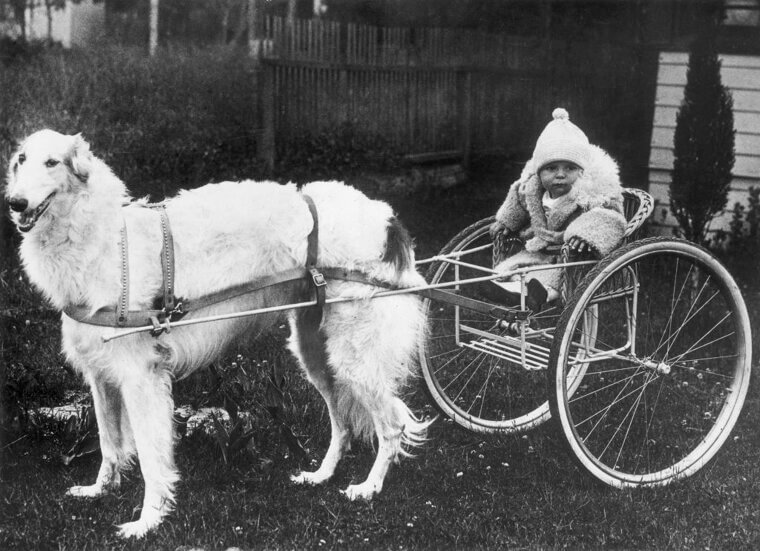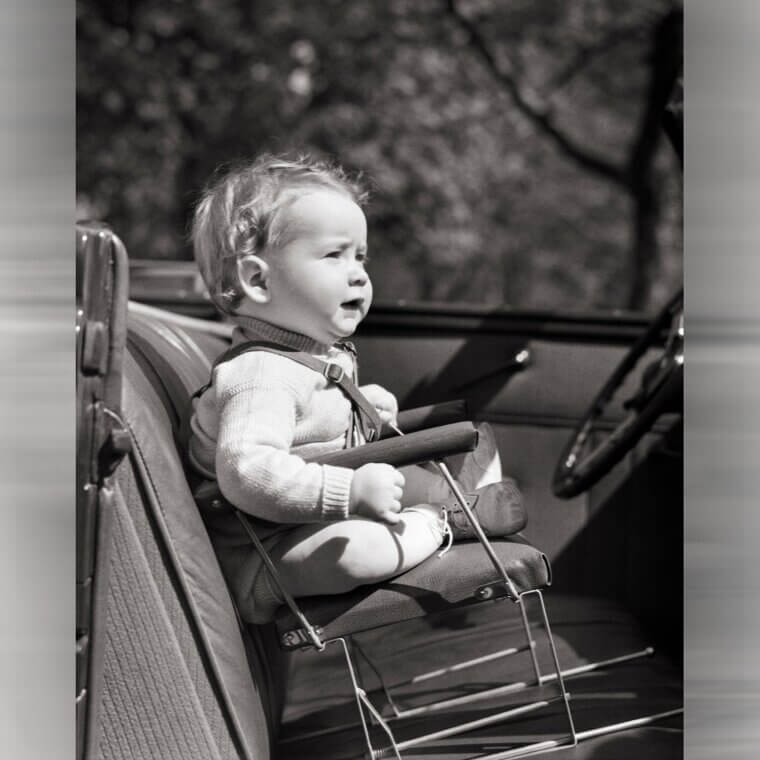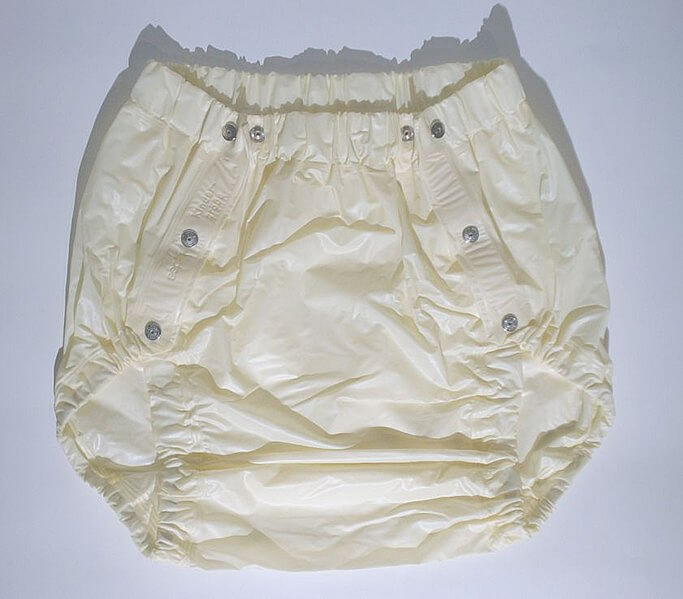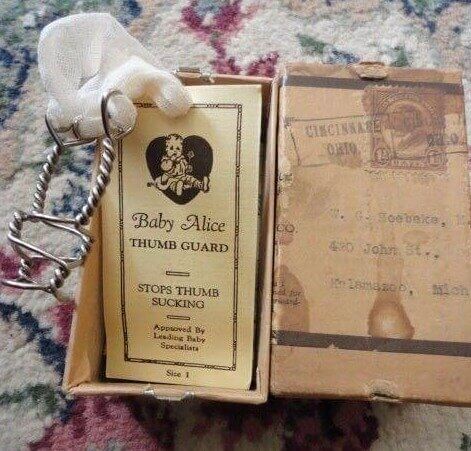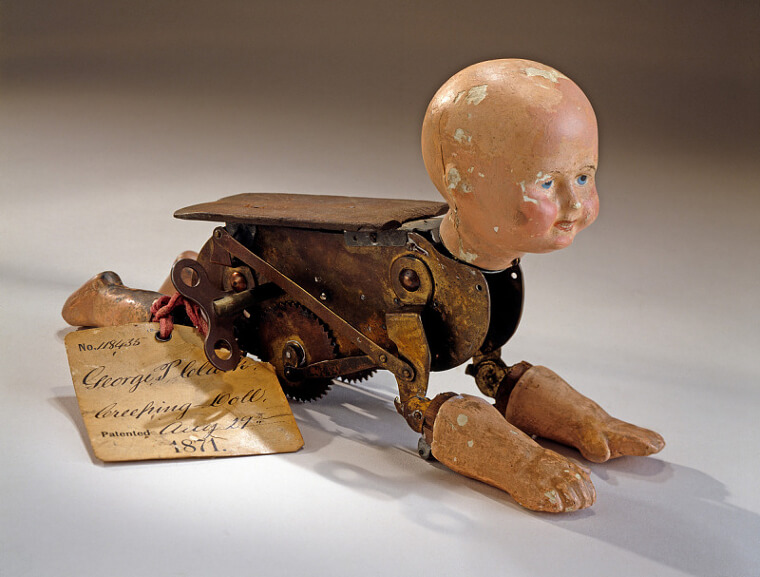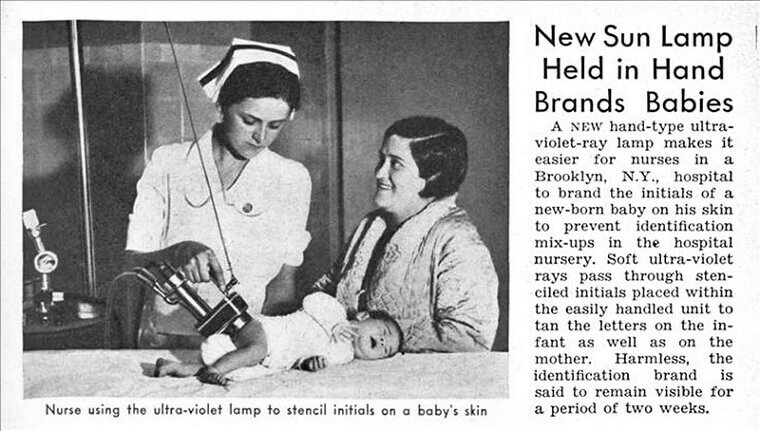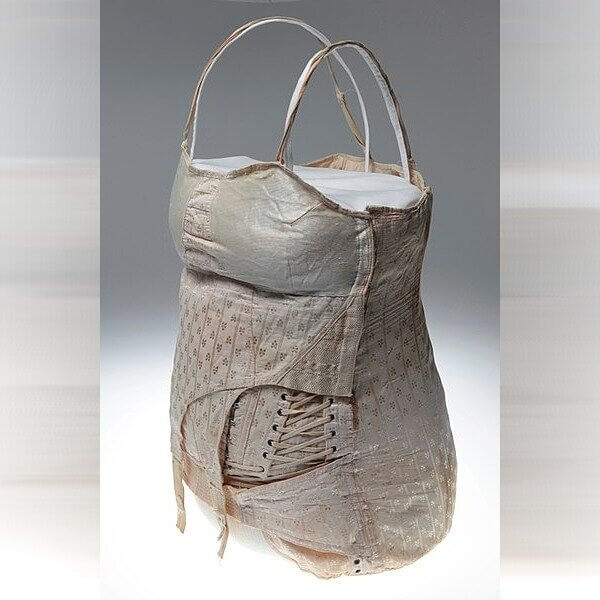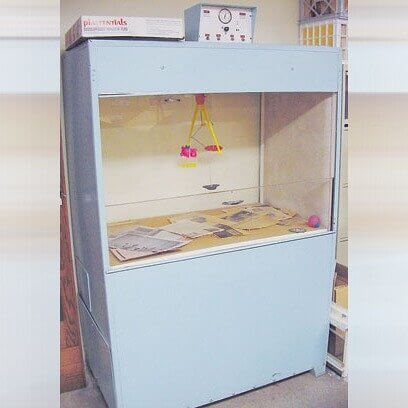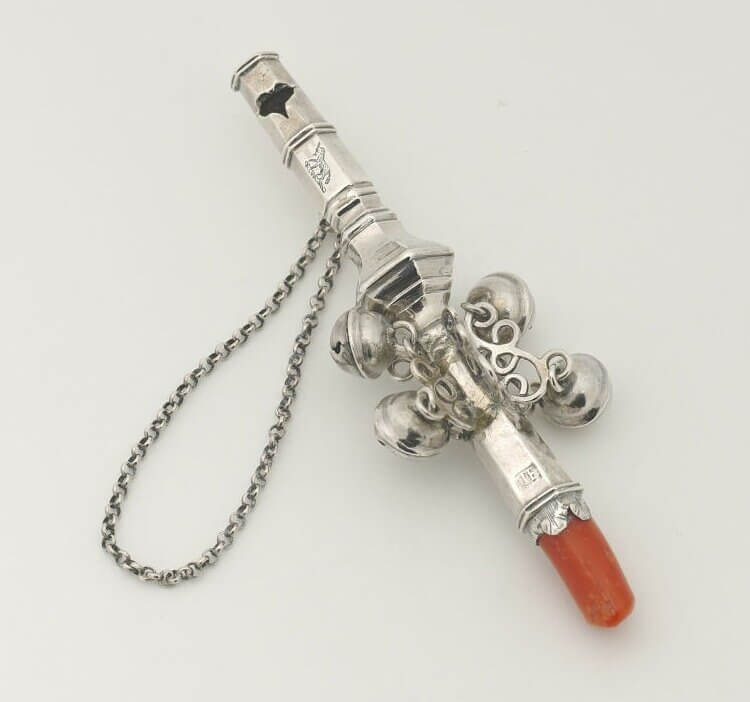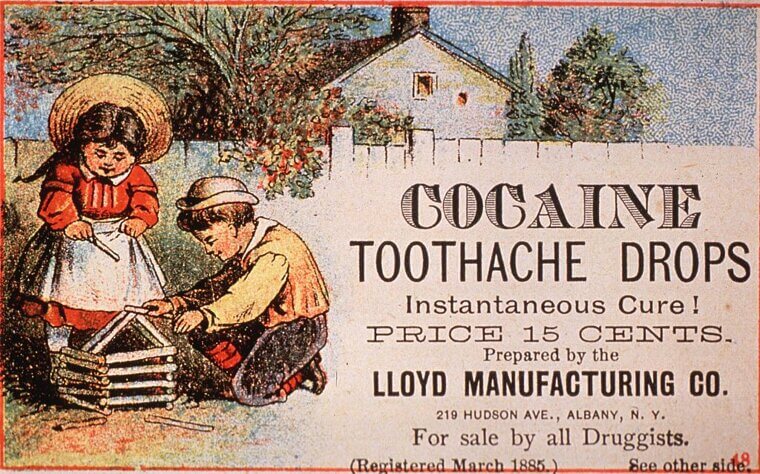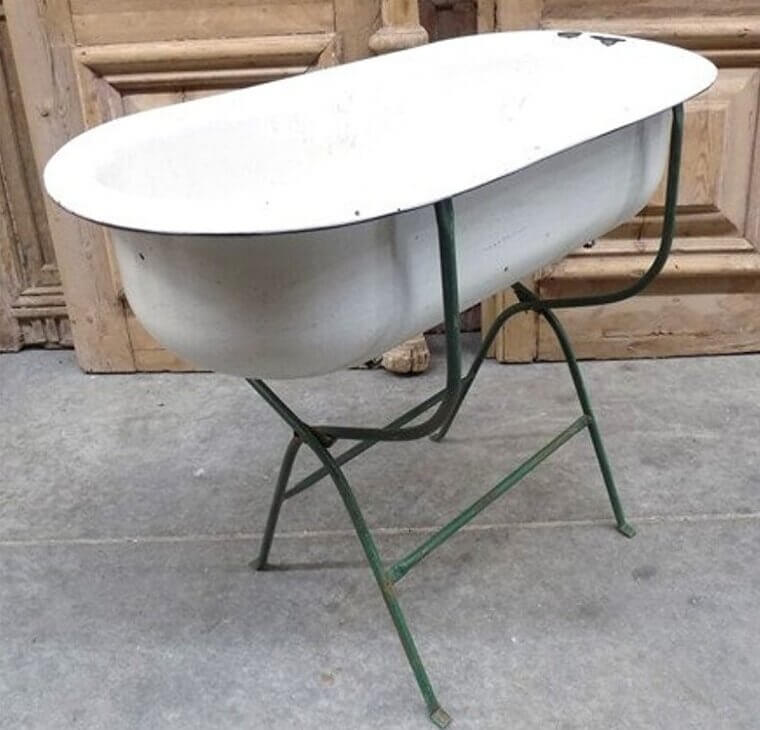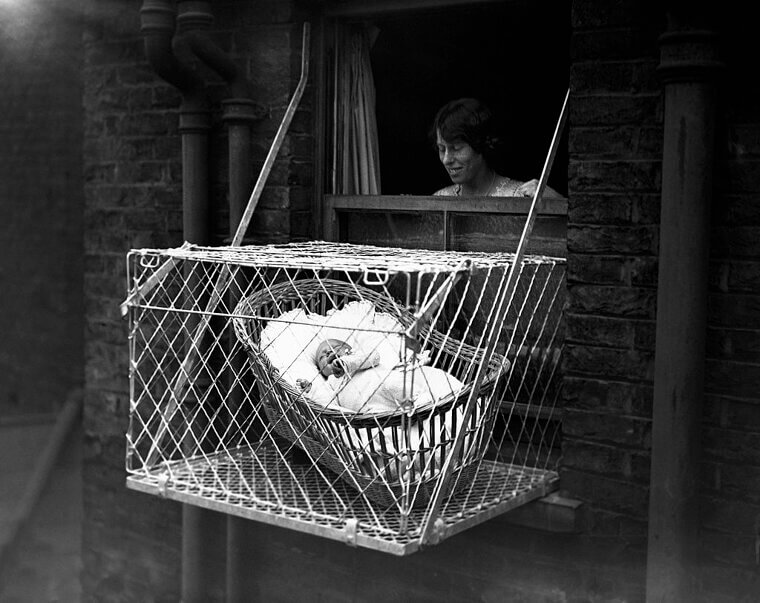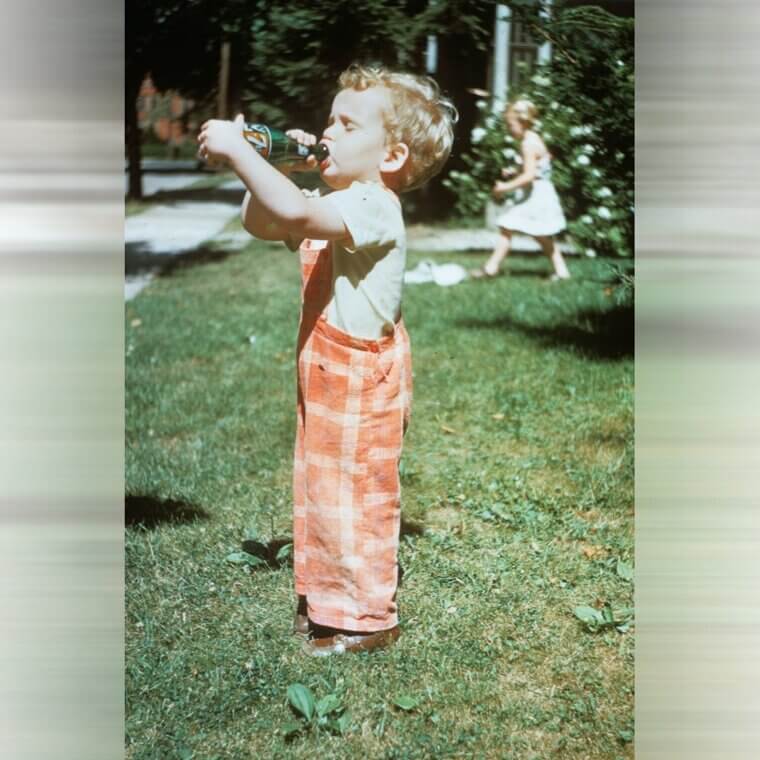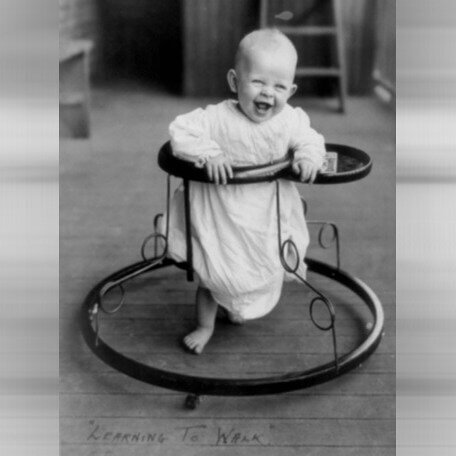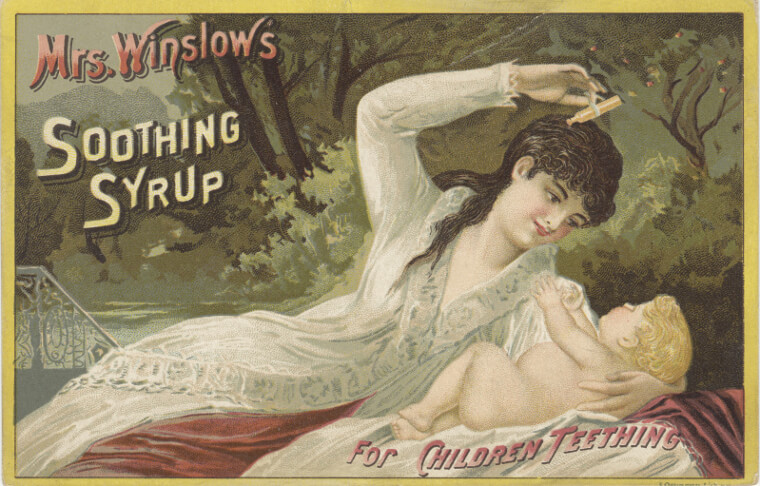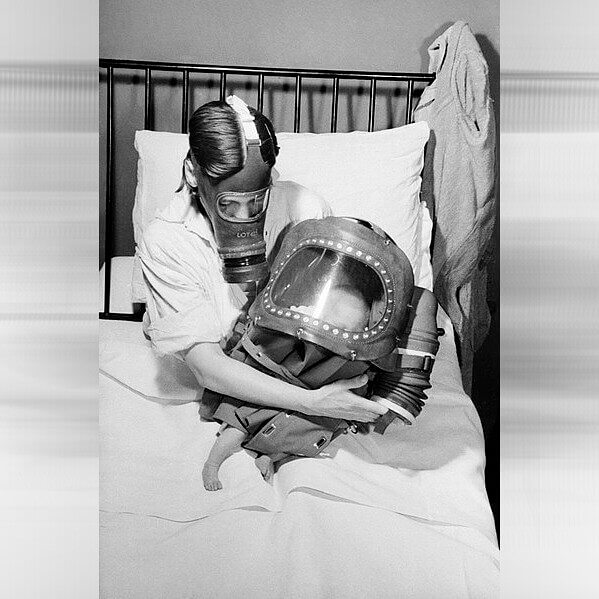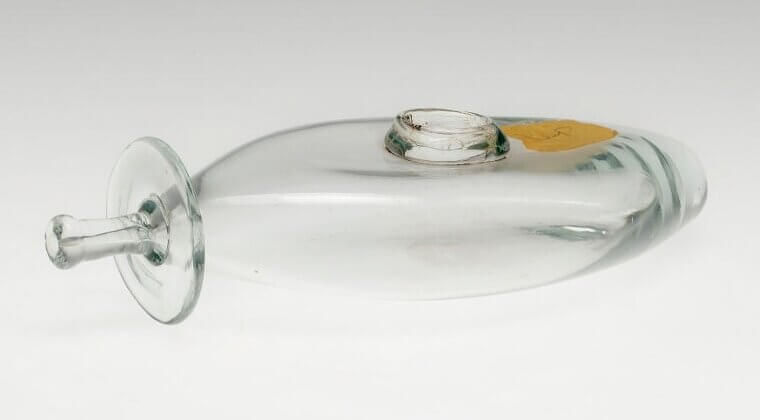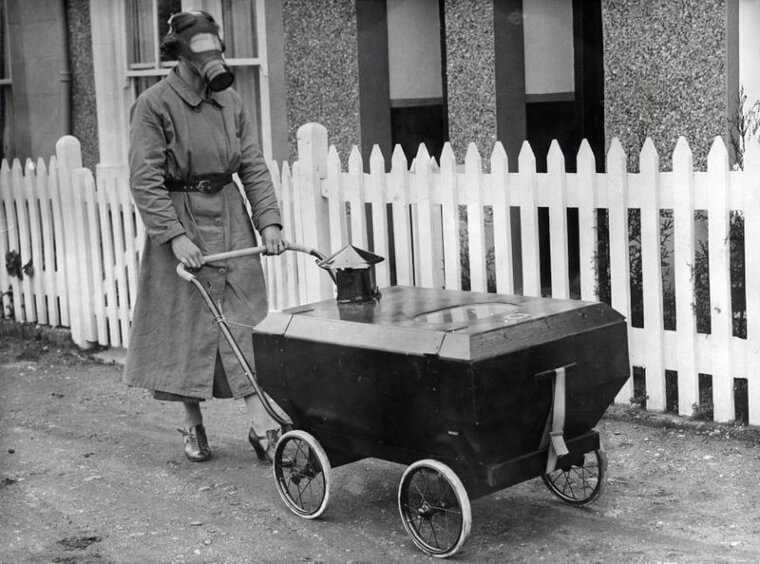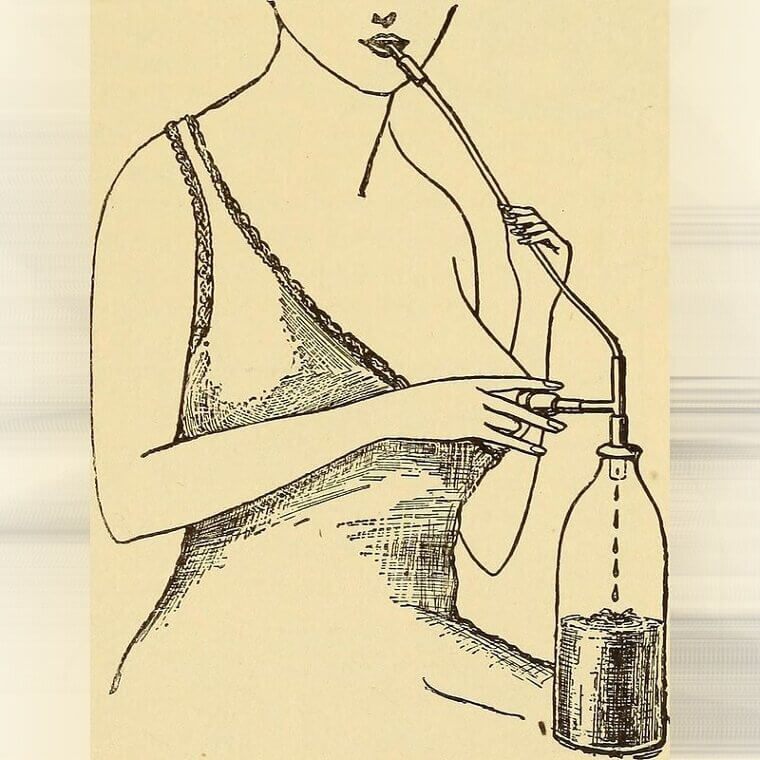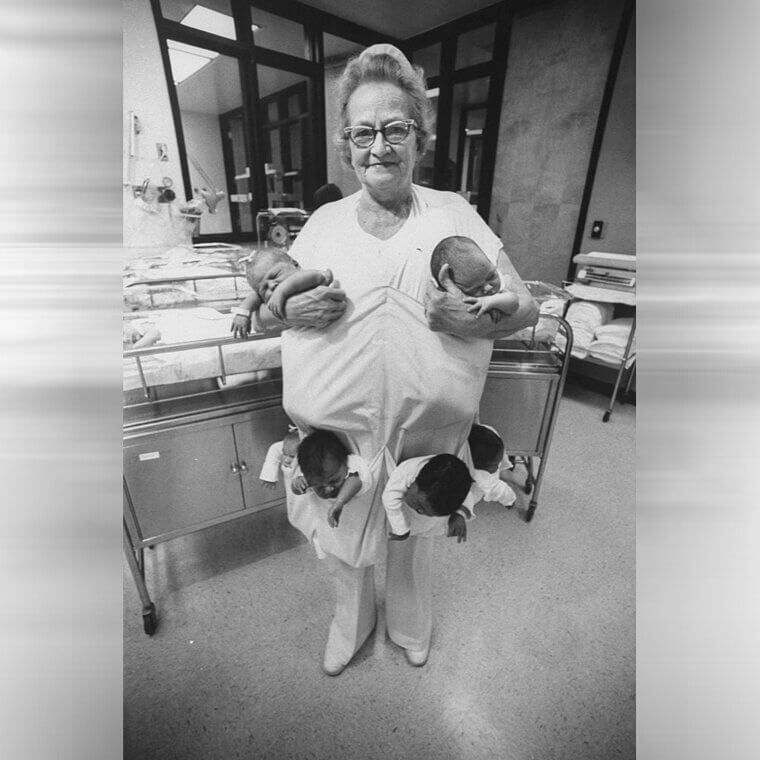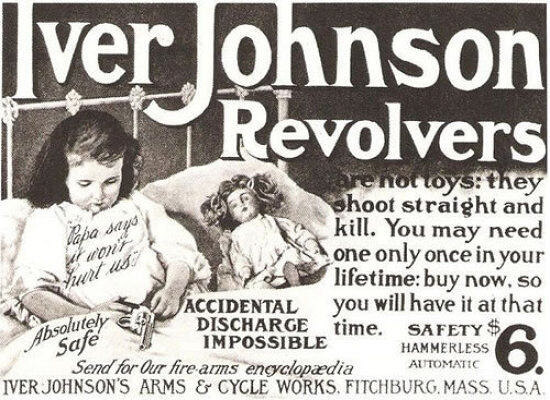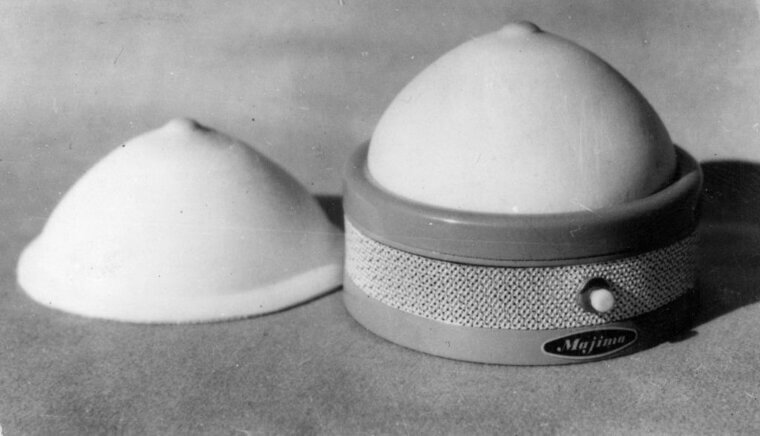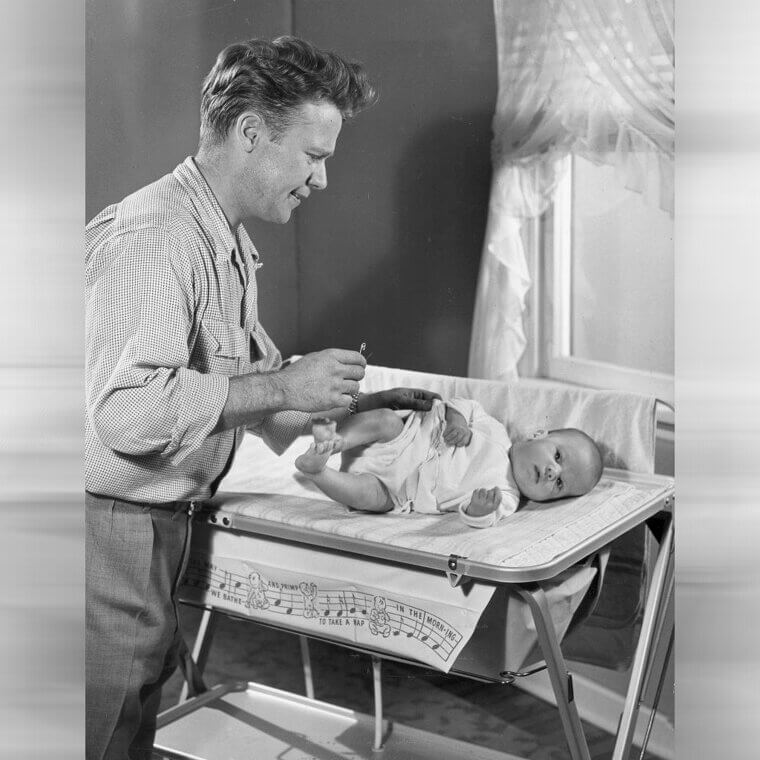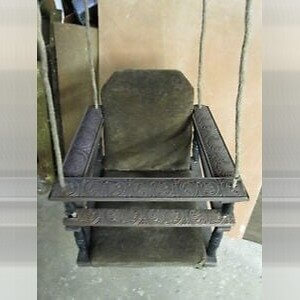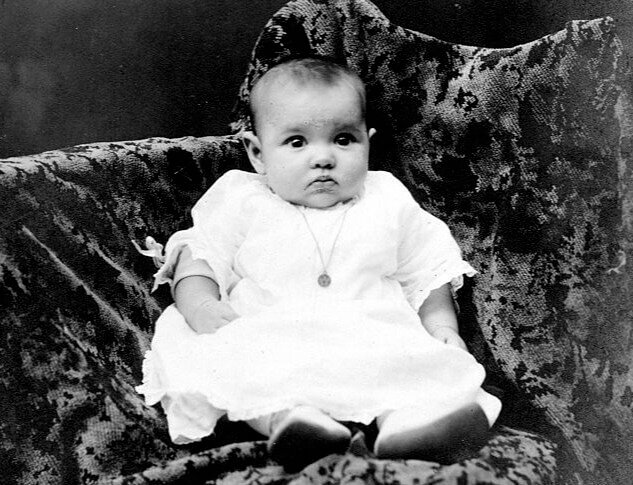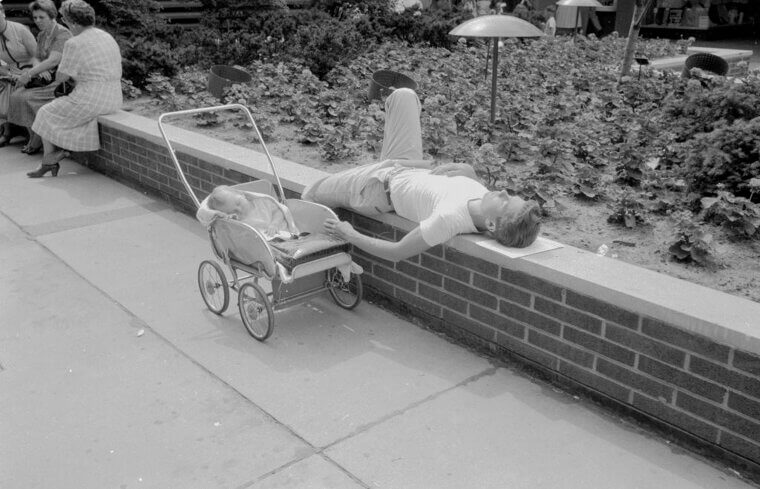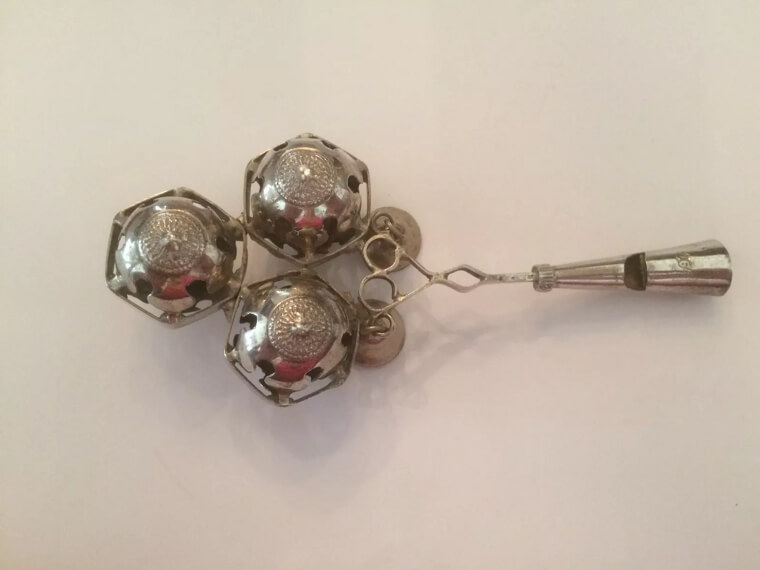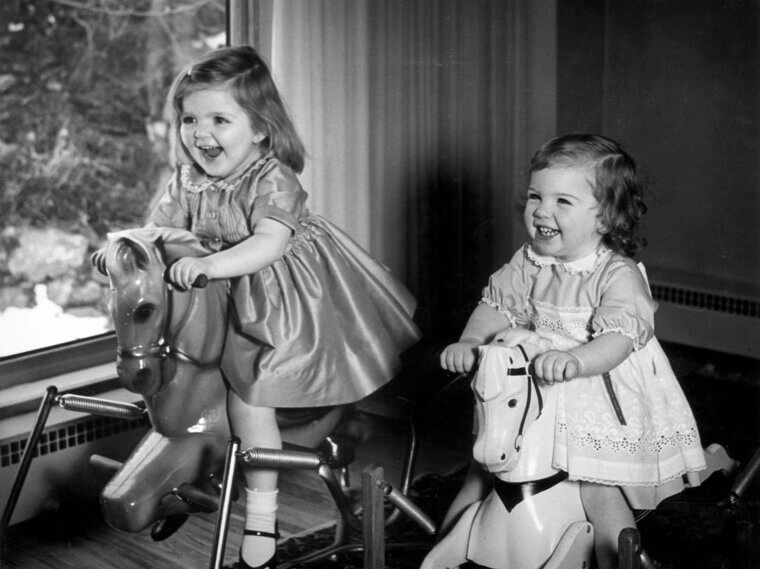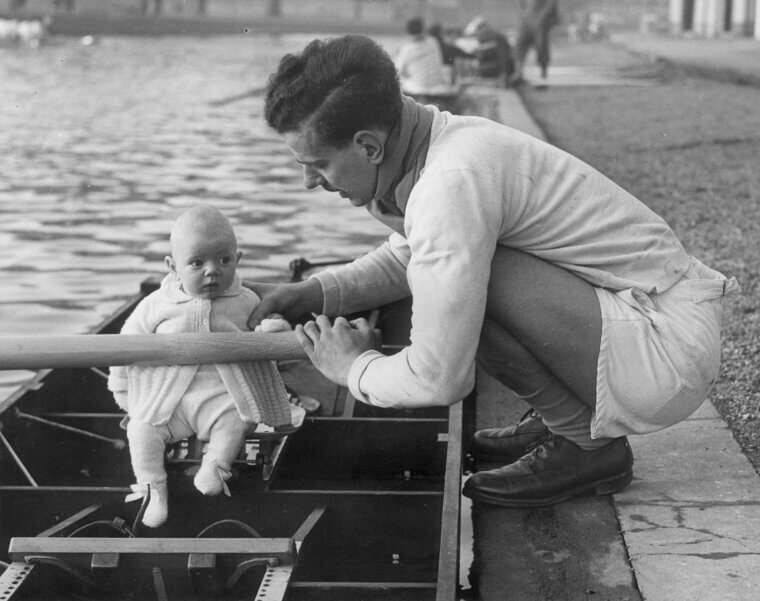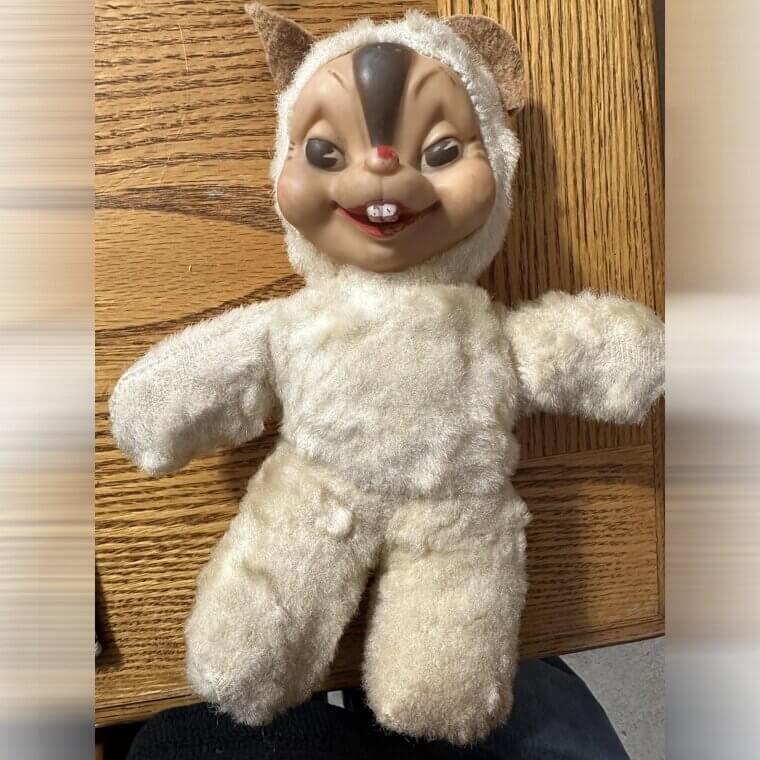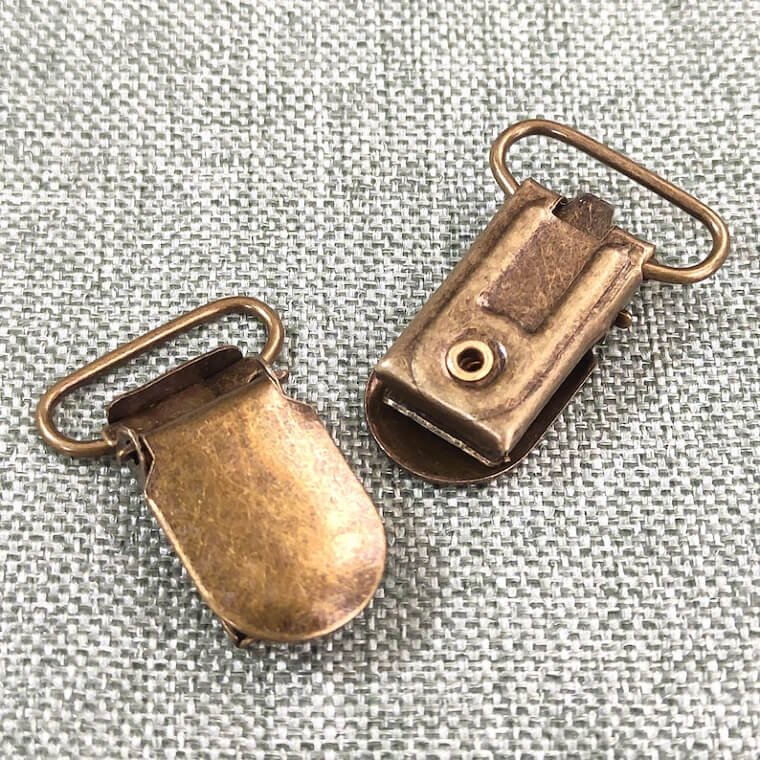A Dog-Drawn Baby Carriage
You may be familiar with horse-drawn carriages that used to help adults (sometimes with their kids) travel back in the day. But have you ever seen a dog-drawn carriage made exclusively to carry a baby (alone)? Well, if you hadn't before, now you have. Yes, this is a real device that existed and parents somehow felt comfortable putting their babies in. Nowadays, this would never be allowed - especially without a helmet!
But the wild part is that this is one of the more tamed baby items on this list. Yes, really. After all, how bad can it be to get driven around by man's best friend?
First Edition Car Seat, Featuring Wire, No Safety Belt, and the Front Seat of a Convertible
Surely, a baby car seat is meant to provide safety for infants, not put them in more danger. However, the first-ever car seats leave a lot to be desired. In the 1950s, they consisted of a bare-bones metal wire frame with just a simple hook attached, and that was pretty much it. Parents would even place their babies up front in the passenger seat using this minimalist apparatus, which would seem crazy by today's standards.
These early baby car seats lacked any child restraint systems to ensure safety for little ones on the road. The most comfort they provided was in the form of a fan attachment on the front.
Rubber Diapers
It wasn't as easy to get your hands on disposable diapers a few decades ago as it is today. They were more expensive and wasteful, which is why most households with an infant used cloth diapers. During the 40s, rubber-bottomed baby pants were introduced and marketed as a great solution. In theory, these waterproof baby pants were easy to clean and reusable, making them a promising alternative to cloth diapers. However, in reality, the lack of breathability and air circulation led to terrible chafing.
They became a nightmare for parents of babies with sensitive skin, and perhaps inevitably, they were soon abandoned in favor of the long-standing use of cloth diapers.
Wire Thumb Guard
Thumb sucking has been happening since the beginning of mankind. While it may be a concern for parents, we can't imagine how this thumb-sucking discouraging device ever came to be. This scary-looking metal wire contraption was supposed to prevent babies from accessing their thumbs and thereby discourage thumb sucking entirely. The creators marketed it as 'safe, sanitary, comfortable,' and alleged that it was 'approved by leading baby specialists.' According to them, 'thumb sucking can be immediately corrected with the Baby Alice Thumb Guard.'
Perhaps it was as comfortable as the manufacturers claimed it to be. However, there's just something about fastening a baby's hand into a coiled wire cuff that sets off alarm bells in our mind.
Mechanical Doll
Not every idea is a good one, and this particular baby toy exemplifies that truth. During the Industrial Revolution of the late 18th century and throughout the 19th century, industrialization and mechanical innovation experienced notable advancements. It was during this period that this terrifying mechanical baby doll was created, designed to scuttle along the floor and supposedly crawl like a real-life baby. However, in reality, it looks like something out of a horror movie.
Besides the nightmare-inducing appearance of the toy, these exposed mechanical gears pose a serious threat to little ones. Regardless, this 1871 doll flew off the shelves during the late 1800s.
Baby Branding UV Lamp
Things have certainly changed in the last few years. Back in the 1950s, hospitals needed a way to keep track of babies, and somehow they landed on this idea. They decided to brand newborns with a UV lamp that burned the initials of the child directly onto their skin and thereby, prevent unfortunate mix-ups. All we can think is, surely there must have been another way to keep track of the children?
Essentially, these UV lamps would leave behind a serious tan on the sensitive skin of a newborn child. Thank goodness hospitals eventually developed other, less damaging processes and systems.
Maternity Corset
Women were under significant pressure to conform to the beauty standards of the day, and not even pregnancy was exempt. That's why this tightly-laced maternity corset was seen as an effective solution for the growing belly of a pregnant woman, promising to cinch up in all the right places. Not only would it have been incredibly uncomfortable to wear all day, but it may have also posed a risk to the unborn child.
Pregnancy is uncomfortable at the best of times, so we can only imagine how much women had to endure when they were pressured to wear one of these during the gestational period.
Baby Safe Razor
We're happy to say that Gillette Razors didn't market directly to little ones at the start of the 20th century. However, they did choose to use babies in their advertising campaigns starting around 1905. They would feature an image of an infant holding one of their razors with shaving foam on their face and the caption, 'begin early - shave yourself'. This was quite a risky campaign, especially considering their razor was called the 'safety razor', which could lead to a misunderstanding of how dangerous these sharp blades could be.
With such frivolous advertising, it was easy for parents to assume that babies would be safe around a Gillette Razor and perhaps overlook the dangers.
The "air Crib," AKA a Glass Cage to Put Your Baby in
This 1944 invention was the brainchild of American psychologist B. F. Skinner, who saw the need for a completely sealed glass crib for infants. If you're thinking it looks more like a baby-sized fish tank, you're not alone; this peculiar crib design aimed to keep babies germ-free and shielded from cold air. The idea was that the enclosed environment would allow babies more freedom of movement, as they wouldn't need to be bundled up in layers of clothes.
Despite Skinner's intention to create a safer environment for little ones, there's something about this slightly terrifying invention that sends chills down our spines rather than offering peace of mind.
A Painful-Looking Teething Stick
We have to give credit to the Victorians for their intricate metal designs, but this silver baby rattle may have gone too far by combining a loud toy with a bright red teething stick at the end. This design ensures that whenever a baby seeks to relieve their sore gums, they'll also make a lot of noise. Moreover, it was even designed to hang around a baby's neck, ensuring constant rattling throughout the day. Surely, parents could have done without this combination.
Not to mention, the dangling silver rattling elements on the outside of the toy must have posed a choking hazard to babies, who are known for putting things in their mouths.
Some Interesting Toothache Drops
It seems as though the Victorian era was a scary time to be a baby. One solution to aid teething babies was to give them these "special" toothache drops that claimed to 'instantly cure' the aches and pains of a teething child. However, this highly addictive substance may have created as many problems as it helped solve, as its stimulating properties are sure to have kept the baby and its parents up all night.
This certainly wasn't a well-thought-out product. However, being sold to consumers by a reputable manufacturer, the damaging effects of these toothache drops weren't as understood as they are today.
Lofty Baby Bath
All sorts of baby bath tubs are used around the world, from wooden baths to plastic tubs and sometimes even just a kitchen sink - there are all sorts of containers used for bathing little ones. However, during the Victorian era, parents used a risky-looking ceramic baby bath that was suspended from a lofty height on tall metal poles. There's something about the weight distribution that makes this baby bath look quite risky.
This baby bath lacks the safety and ergonomic design features found in today's baby baths. Instead, this Victorian version looks unstable and like an accident waiting to happen.
Wash-Free Baby Bottle
The Victorians had some interesting baby gadgets that wouldn't fly today. One of them was this feeding bottle, designed to relieve parents of the responsibility of constantly washing baby bottles. It seemed like the perfect solution to save tired parents time and energy, but soon enough, parents realized it wasn't all it was cracked up to be. This ingenious feeding bottle was made of glass and had a rubber straw attached for drinking, along with another attachment for mothers to deposit breast milk.
But once it was discovered that these feeding bottles were actually a breeding ground for harmful bacteria, it no longer seemed worth the risk to the baby's health. Who would have guessed?
Window Crib
At the beginning of the 20th century, parents became increasingly concerned about ensuring their children received enough fresh air. American pediatrician Luther Emmett Holt was a vocal advocate for recognizing the benefits of fresh air for youngsters, which inspired him to devise a rather alarming contraption for inner-city families with limited access to green spaces. In 1919, he introduced the 'window crib' for babies, which saw infants suspended in a metal cage outside of city apartments.
If someone were to use one of these terrifying 'window cribs' today, it would almost certainly lead to several complaints and likely a visit from child protective services!
7up for Kids
Things were very different in the 1950s compared to today. For example, the fizzy drink brand 7UP decided to market their sugary beverages to babies. In their advertisements, they featured a picture of a baby consuming the drink with the caption, 'This young man is 11 months old - and he isn't our youngest customer by any means.' They claimed that 7UP was so 'pure and wholesome' that you could even give it to babies and feel good about it.
Today, we are well aware of how detrimental these sodas can be to our health, which is why the idea of 7UP marketing to babies feels unsettlingly dystopian.
Metal Walking Hoop
Today, there are tons of baby toys designed to help little ones learn how to balance their weight, stand up straight and eventually walk. These toys often come in bright colors and lightweight plastic materials to keep the baby engaged and safe. However, in the past, the only baby walking device to hit the market was a hard metal walking hoop that lacked the bells and whistles we've come to expect.
In fact, we see potential risks. Not only are there sharp metal edges at the contraption's fastening points, but the small wire hoops look like a potential hazard for getting an arm stuck.
"Soothing" Syrup
These days, there are many different remedies for soothing teething babies who are in discomfort. However, back in the 1800s when information was less accessible, products like Mrs. Winslow's Soothing Syrup promised to be effective solutions during this restless period in a baby's life. The only problem was that it contained an ingredient now used for severe pain in adults, and is an addictive and dangerous substance rarely prescribed in today's world. Sadly, Mrs. Winslow's Soothing Syrup was a huge hit with parents.
Thankfully, the American Medical Association strongly criticized the use of this product in 1911 after a great number of unfortunate incidents came to light. However, it wasn't officially removed from the shelves until 1930.
Baby Gas Mask
The uncertain times in Europe during the Second World War made this scary-looking device a necessity. People needed to protect themselves against the possibility of chemical attacks from warring countries, so every household had to acquire gas masks for every member of the family, including children. The baby gas masks were much larger than those for adults, as they were not strapped onto the head but placed over the entire baby's body.
Much like the instructions given on planes regarding oxygen masks, parents were instructed to fasten their masks on themselves first before securing their baby's mask.
Crystal Baby Bottle
Parents today wouldn't dream of giving a child something as easy to break as glass. But the truth is, parents used to feed their children with glass baby bottles. If you were upper class, you'd be able to afford intricate crystal glass baby bottles with a silver-topped lid. For those who were less economically fortunate, they would rely upon cheaper glass bottle alternatives that were even more likely to shatter. We can't think of a less safe material to give to a baby.
For those unable to afford glass baby bottles, mothers would usually breastfeed their infants until they were old enough to drink from regular cups used by adults.
Gas Attack Pram
People had to get creative during the Second World War. With countries in Europe under the threat of chemical attacks, they found ways to protect themselves and their little ones. One method of preparation was the use of a gas attack pram designed to shield babies from poisonous gases in the air. These sturdy metal contraptions provided parents with a way to stroll their babies in the streets during these terrifying times.
In today's world, we couldn't possibly imagine putting a baby in one of these chilling metal chambers. While we appreciate their purpose, couldn't they have painted them a more cheerful color?
Suction-Powered Breast Pump
Breast pumps are frequently relied upon today for good reason. They allow breastfeeding mothers to collect milk for later use, ensuring that babies can be fed whenever they need to, even if the mother isn't present. Additionally, breast pumps can help increase milk production, so they're an especially useful tool to have. While hand-pumping or mechanical breast pumps are common today, in the Victorian era, glass breast pumps were used.
These pumps required you to suck on one end of the pump via a rubber straw, which siphoned the milk and collected it in the glass bottle. It's good to see that methods have evolved.
The Original Evacuation Pouch
This next gadget might look creepy, but it's actually one of the top baby gadgets on this list and an updated version of it is still used today. Pictured below is pediatric nurse Vera Leonard wearing the evacuation gown she invented. The tool was made of heavy duck fabric and featured six kangaroo-like pouches. The whole point of Vera's invention was to have a safe and effective way to evacuate newborns in the hospital if there was ever a fire.
This is one gadget that made an impact and continues to be put to use today (with an updated version that's safer than this one, of course).
"Child-Safe" Revolver
Fortunately, this revolver manufacturer wasn't bold enough to directly market to babies. However, they did use children in their advertising campaigns in a rather alarming way. Iver Johnson Revolvers claimed that their firing pistol was so safe to have around the house that even a child could pick it up and play with it without any risk. According to them, 'accidental discharge [is] impossible,' and the revolver was deemed 'absolutely safe.'
All the while, this revolver was intended to do exactly what a revolver does best. How times have changed since 1903 when this ad was placed.
Artificial Breasts With a Heartbeat as a Sleeping Aid
We all know babies have a natural inclination towards breastfeeding and anything similar to it, so it might not be so shocking to see the device below. Someone decided to make artificial breasts with an artificial heartbeat that would help babies fall asleep. However, while the idea sounds nice, in practice, the gadget looks like it should be kept very far away from anyone ages 0-3.
Seriously - imagine putting this in the crib with you child. It seems like a bad naptime waiting to happen, if you ask us.
Diaper Pins
Parents used to use what are essentially giant safety pins to fasten cloth diaper pads for babies. They're called diaper pins, and they definitely leave much to be desired. These oversized pins had to be large and sturdy enough to hold the diaper together, yet sharp enough to pierce through several layers of thick cotton. While effective and affordable, they posed a significant risk to little ones if accidentally opened.
Cloth diaper pads have experienced a resurgence in recent years due to their cost-effectiveness and eco-friendly nature. Fortunately, these days, parents are using velcro, sticky tabs, or metal poppers to fasten them instead.
Iron Baby Swing
The Victorians certainly left much to be desired in regards to child safety. This classic baby swing doesn't seem like something a baby would enjoy, but it was intended to serve as a seating alternative for little ones nonetheless. Often, the legs of smaller baby chairs were removed and attached to the ceiling with ropes or chains, creating a makeshift version of the baby swing. Something tells us they weren't safety checked.
What stands out is how unappealing the Victorian baby swing looks, resembling more of a torture chair than a child's swing. That cold iron armrest couldn't have felt great on the skin.
Baby Jewelry
Many parents today adorn their little ones with miniature-sized baby jewelry. But back in the day, little thought went into the materials used for baby jewelry from a health and safety perspective. Often, baby jewelry was made with toxic metals, and it frequently featured small details, little gems and tiny dangling elements. These posed serious hazards for babies, who often try to put anything and everything in their mouths.
Unsurprisingly, baby jewelry from yesteryear was a total choking hazard, not to mention the times when small gems would get accidentally swallowed and were never seen again.
Cymbal Banging Monkey Toy
Musical chimps were a common baby toy in the olden days, and they can still be found today. Typically, they consist of a smiling monkey doll dressed in circus clothes, holding two cymbals and making noise when banged together. It's a mechanical toy that also had the ability to screech and show its teeth. However, this particular 50s model looks anything but safe for children, mainly due to its extremely disturbing facial expression.
All we can think is, parents of the 50s were a lot more lenient when it came to their kids if they brought home a maniacal monkey toy like this.
Strap Free Stroller
Baby strollers have straps for a reason, but in the Victorian era, they didn't consider this an essential feature. Properly strapping your baby in ensures they won't accidentally fall headfirst onto hard pavement and get injured. However, back then, parents were willing to risk it, simply sitting their child in the stroller and hoping for the best. Considering how common it is for strollers to stumble or jolt over potholes or uneven pavement slabs, we can only imagine how much worse the roads might have been at the time.
There's no doubt in our minds that accidents were likely far more common during this period, given that babies weren't securely fastened to their strollers.
Rattling Baby Whistle
Typically, new parents look for ways to reduce the noise made by their little ones. But the Victorians came up with this interesting baby toy that both rattles and whistles, all at the same time. We understand that they were going for the 'two birds, one stone' approach, but we really think this vintage baby toy should have been reconsidered before production. It must have been a noisy nightmare for the people around.
We understand that babies love a good rattle toy, but we're not convinced that adding a whistle was necessary, especially considering the toy is already loud!
Legless Rocking Horse
The rocking horse is a classic children's toy that often gets passed down from generation to generation. For some families, they're essentially an heirloom that can be enjoyed for several years to come. However, a vintage rocking horse like this one leaves a lot to be desired. For one, this horse is attached to a set of springs, which definitely don't look safe for kids who could easily get their small fingers caught.
Ignoring the safety hazard that this rocking horse poses, it has an especially terrifying appearance that's sure to scare children. Did they really need to give it giant orbs for eyes?"
Row Boat Baby Seat
Sometimes, childcare advice from the past can be as unsettling as some of the gadgets and gizmos parents used. One particular piece of advice that hasn't aged well comes from pediatrician John B. Watson in his 1928 book Psychological Care of Infant and Child. In it, he urged parents to be cautious about showing affection, stating, 'Never hug or kiss them, never let them sit in your lap. If you must, kiss them once on the forehead when they say goodnight.'
He also added, 'There is a sensible way of treating children. Treat them as if they were young adults.' According to him, this included giving them a brisk handshake in the morning to start the day.
Limbless Squirrel Doll
Children's toys from the past can have an eerie quality to them, often due to the fact that the aging process has not been very kind. However, in the case of this baby toy, it simply has a terrifying facial expression. Whoever thought this would appeal to children rather than give them nightmares must not understand kids very well, as the menacing appearance definitely doesn't make it seem suitable for little ones.
Even when it comes to the body of the doll, where are its arms and legs? You'd hardly guess that this toy was meant to resemble a squirrel.
Bronze Pacifier Clips
Parents have been using pacifiers for ages to keep their little ones content. Before safety-regulated silicone pacifiers were a thing, babies had to make do with metal or bronze ones. They were easy to attach to a baby's clothes and easy to produce and affordable in price. However, the metal or bronze materials could pose a risk to little ones due to their hardness due to the sharp crocodile teeth.
It's easy to imagine a situation where a child removes the pacifier from their clothes, gets a finger caught in the metal or bronze teeth, and accidentally hurts themselves.
Electrician's Kit for Babies
It's always good to show kids all the different jobs that exist and help them believe that they can be anything when they grow up. But the key is that - when they grow up. We don't need to hand babies or toddlers an electricians' kit and then let them play with actual electronics. If they're called to be an electrician, it'll happen without having to put them in danger as babies.
But parents back then knew a lot less than we do today and had less access to information, so we can't blame them for their missteps.

